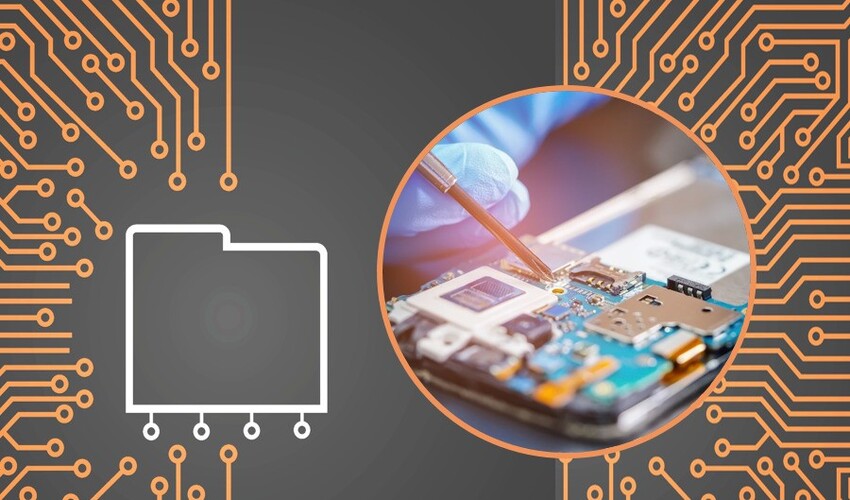Sensors are essential in modern tech. They detect and measure physical properties and convert them into signals that can be read and analyzed. They are crucial in many applications, from industrial automation to consumer electronics, healthcare technology, and environmental monitoring. This essay explores different types of sensors, covering their principles of operation and their use in many fields.
Types of Sensors
Let’s discuss Types of Sensors, their overview and their application
1. Temperature Sensors
Overview
Temperature sensors measure heat in an object or environment. They provide readings in units such as Celsius, Fahrenheit, or Kelvin. They are widely used in various industries for monitoring and control purposes.
Types
- Thermocouples: Consist of two different metals joined at one end. They measure temperature by producing a voltage that correlates with temperature changes.
- RTDs (Resistance Temperature Detectors) use a simple principle: Metals’ resistance changes with temperature. Made from materials like platinum, they provide accurate temperature measurements.
- Thermistors: Made from ceramic materials, these types of sensors change resistance with temperature. They are susceptible and used for precise temperature control.
- Infrared Sensors: Measure temperature by detecting infrared radiation emitted by an object. They are used in non-contact temperature measurements.
Applications
- Industrial processes involve monitoring and controlling temperatures. This happens in manufacturing, chemical reactions, and power plants.
- HVAC Systems: Maintaining optimal temperatures in heating, ventilation, and air conditioning systems.
- Medical Devices: Monitoring body temperature in clinical thermometers and patient monitoring systems.
- Consumer Electronics: Temperature regulation in computers, refrigerators, and ovens.
2. Pressure Sensors
Overview
Pressure sensors measure the force exerted by a fluid (liquid or gas) on a surface. They are vital in many applications; pressure monitoring and control are crucial.
Types
- Strain Gauge Sensors: Measure pressure by detecting the deformation of a diaphragm or other mechanical structure.
- Capacitive Sensors: Measure changes in capacitance caused by the deformation of a diaphragm.
- Piezoelectric Sensors: Utilize the piezoelectric effect, where materials generate an electric charge in response to applied mechanical stress.
- Optical Sensors: Use light to measure changes in pressure.
Applications
- Automotive Industry: Monitoring tyre pressure, engine oil pressure, and fuel pressure.
- Aerospace: Measuring cabin pressure, altitude, and airspeed.
- Medical Devices: Blood pressure monitors and respiratory devices.
- Industrial Processes: Monitoring pressure in pipelines, tanks, and hydraulic systems.
3. Proximity Sensors
Overview
Proximity sensors detect the presence or absence of an object within a specific range without physical contact. They are widely used in automation and security systems.
Types
- Inductive Sensors: Detect metallic objects by generating an electromagnetic field and measuring changes in inductance.
- Capacitive Sensors: Detect both metallic and non-metallic objects by measuring changes in capacitance.
- Ultrasonic Sensors: Use sound waves to detect objects and measure distance.
- Infrared Sensors: Use infrared light to detect objects and measure distance.
Applications
- Industrial Automation: Detecting the presence of objects on conveyor belts, in assembly lines, and in robotic systems.
- Automotive Industry: Parking sensors and collision avoidance systems.
- Consumer Electronics: Proximity sensing in smartphones and tablets.
- Security Systems: Motion detection and intrusion detection systems.
4. Light Sensors
Overview
Light sensors measure light’s intensity. They are used in applications where light levels need monitoring and control.
Types
- Photodiodes: Semiconductor devices that convert light into an electrical current.
- Phototransistors: Similar to photodiodes but with higher sensitivity and amplification.
- LDRs (Light Dependent Resistors): Change resistance based on the amount of light falling on them.
- Optical Sensors: Use various principles, such as changes in reflectance or transmission, to measure light intensity.
Applications
- Consumer Electronics: Automatic brightness adjustment in smartphones, tablets, and TVs.
- Environmental Monitoring: Measuring sunlight and UV radiation levels.
- Industrial Automation: Detecting product presence and positioning in manufacturing processes.
- Security Systems: Light-sensitive alarms and surveillance systems.
5. Motion Sensors
Overview
Motion sensors detect movement. They are widely used in security, automation, and consumer electronics.
Types
- Passive Infrared (PIR) Sensors: Detect infrared radiation emitted by moving objects, particularly humans.
- Ultrasonic Sensors: Emit ultrasonic waves and measure the reflection to detect motion.
- Microwave Sensors: Use microwave radar to detect movement.
- Accelerometers: Measure changes in velocity or acceleration, commonly used in detecting motion and orientation.
Applications
- Security Systems: Motion detection for alarm systems and surveillance cameras.
- Consumer Electronics: Motion detection in gaming consoles, smartphones, and fitness trackers.
- Automotive Industry: Airbag deployment systems and anti-theft systems.
- Industrial Automation: Detecting machine movements and positioning.
6. Humidity Sensors
Overview
Humidity sensors measure the moisture content in the air. They are crucial in maintaining optimal environmental conditions in various applications.
Types
- Capacitive Sensors: Measure humidity by detecting changes in capacitance caused by moisture absorption.
- Resistive Sensors: Measure changes in electrical resistance due to moisture absorption.
- Thermal Sensors: Measure humidity by detecting changes in thermal conductivity caused by moisture in the air.
Applications
- HVAC Systems: Monitoring and controlling humidity levels in heating, ventilation, and air conditioning systems.
- Agriculture: Monitoring soil moisture and environmental humidity for optimal crop growth.
- Consumer Electronics: Humidity control in devices like humidifiers and dehumidifiers.
- Industrial Processes: Maintaining humidity levels in manufacturing environments and storage facilities.
7. Gas Sensors
Overview
Gas sensors detect the presence and concentration of gases in the environment. They are essential for safety, environmental monitoring, and industrial processes.
Types
- Electrochemical Sensors: Measure gas concentration by generating a current in response to a chemical reaction.
- Infrared Sensors: Detect gases by measuring the absorption of infrared light.
- Metal-Oxide Semiconductors (MOS): Measure changes in resistance caused by gas adsorption on the sensor surface.
- Catalytic Bead Sensors: Detect flammable gases by measuring the heat of combustion.
Applications
- Environmental Monitoring: Detecting air pollution and monitoring air quality.
- Industrial Safety: Monitoring toxic and flammable gases in industrial environments.
- Medical Devices: Monitoring respiratory gases in healthcare settings.
- Consumer Electronics: Gas detectors and alarms for homes and buildings.
8. Accelerometers and Gyroscopes
Overview
Accelerometers and gyroscopes measure acceleration and angular velocity, respectively. They are widely used in motion sensing and orientation detection.
Types
- Piezoelectric Accelerometers: Use the piezoelectric effect to measure changes in acceleration.
- Capacitive Accelerometers: Measure changes in capacitance caused by acceleration.
- MEMS (Micro-Electro-Mechanical Systems) Gyroscopes: Use micro-machined components to measure angular velocity.
Applications
- Consumer Electronics: Motion detection in smartphones, tablets, and gaming consoles.
- Automotive Industry: Stability control systems and airbag deployment.
- Aerospace: Navigation and flight control systems.
- Industrial Automation: Monitoring vibrations and machine movements.
9. Magnetic Sensors
Overview
Magnetic sensors detect magnetic fields. They are used in many positions, orientations, and current sensing applications.
Types
- Hall Effect Sensors measure magnetic fields using the Hall Effect. A voltage is generated perpendicular to an electric current in a conductor.
- Magnetoresistive Sensors: Measure changes in resistance due to a magnetic field.
- Fluxgate Sensors: Measure magnetic fields using a core and coils to detect changes in magnetic flux.
Applications
- Consumer Electronics: Compasses and position tracking in smartphones and tablets.
- Automotive Industry: ABS (Anti-lock Braking System) and electronic stability control.
- Industrial Automation: Position sensing and speed measurement in motors.
- Medical Devices: Magnetic resonance imaging (MRI) systems.
10. Image Sensors
Overview
Image sensors capture visual information and convert it into electronic signals. They are fundamental in cameras and imaging devices.
Types
- CCD (Charge-Coupled Device) Sensors: Capture light and convert it into electrical charges.
- CMOS (Complementary Metal-Oxide-Semiconductor) Sensors capture light and convert it into electrical signals faster and with less power than CCD sensors.
- Infrared Sensors: Capture images in the infrared spectrum, which is used for night vision and thermal imaging.
Applications
- Consumer Electronics: Cameras in smartphones, tablets, and digital cameras.
- Security Systems: Surveillance cameras and facial recognition systems.
- Automotive Industry: Rearview cameras and advanced driver-assistance systems (ADAS).
- Healthcare: Medical imaging devices like endoscopes and X-ray machines.
11. Acoustic Sensors
Overview
Acoustic sensors detect sound waves and convert them into electrical signals. They are used in various applications where sound measurement and analysis are required.
Types
- Microphones: Capture sound waves and convert them into electrical signals.
- Ultrasonic Sensors: Use high-frequency sound waves to detect objects and measure distances.
- Hydrophones: Capture underwater sound waves for marine and underwater applications.
Applications
- Consumer Electronics: Microphones in smartphones, laptops, and voice-activated devices.
- Automotive Industry: Parking sensors and collision avoidance systems.
- Healthcare: Diagnostic tools like ultrasound machines.
- Industrial Automation: Non-destructive testing and material characterization.
Conclusion
Sensors are vital in modern tech. They enable many applications in many industries. The sensors measure temperature and pressure. They also measure images and sound. Each Type of Sensor is crucial for monitoring, controlling, and optimizing processes. Technology continues to advance. It will bring the development of new, better sensors. The types of sensors will have more uses. They will drive innovation and boost efficiency in many fields. We appreciate the impact of sensors on our lives. They help shape our world. But, to see this, we must understand the types of Sensors and their uses.













